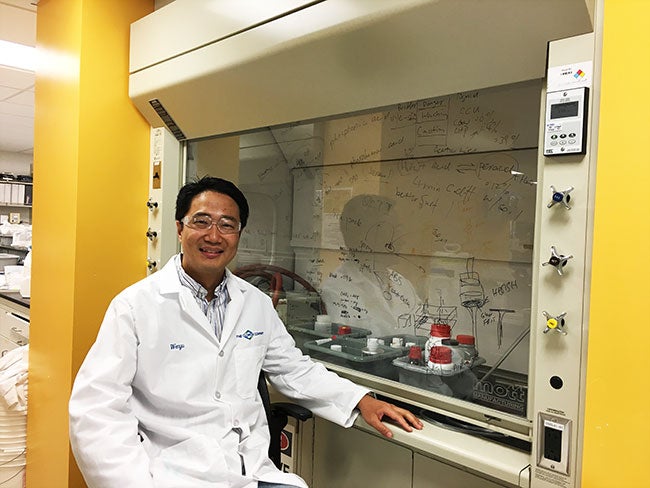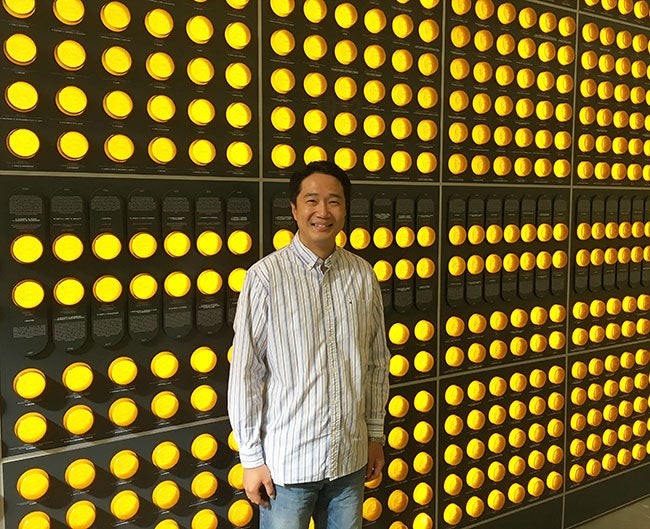Innovation Lessons From a Nobel Laureate
By Wenyu Zhang, Senior Scientist
Most of us who go into science probably dream of winning a Nobel Prize.
But given that only 335 prizes have been awarded in Physics, Chemistry and Medicine since 1901, the odds are pretty slim. So the next best thing we can hope for is that our graduate school advisor becomes a Nobel Laureate. And that’s what happened to me.

Wenyu Zhang in his Clorox lab.
Last week, my PhD advisor, Professor Sir J. Fraser Stoddart, shared the 2016 Nobel Prize for Chemistry with Jean-Pierre Sauvage and Bernard Feringa “for the design and synthesis of molecular machines.” Professor Stoddart is a pioneer in this field, and he taught me several invaluable lessons about innovation and leadership that I apply to my day-to-day work at Clorox.
- Fortune favors the bold
Molecular machines are essentially molecules capable of making controllable, mechanical motions and eventually undertaking complex robotic tasks. This sub-discipline of chemistry — nanotechnology — was radical at its birth three decades ago, and is still cutting-edge today. Its exciting possibilities kept Professor Stoddart pursuing these bold scientific ideas, and the world is beginning to see meaningful applications of molecular machinery. The recognition of his work is a tremendous inspiration to me to think boldly every day and look beyond what’s obvious.
At Clorox, we stress bold thinking as necessary for our growth culture. It is the bedrock of both Research & Development and innovation, as we think up new formulations and exciting ways to use science to bring value to consumer lives.
- Innovation has no boundaries
During my five years of graduate study, I was fortunate to witness and experience the benefits of Professor Stoddart’s ability to collaborate with experts in multiple scientific disciplines. These sprouted radical ideas that bore much fruit, including a molecular memory device the size of a white blood cell that has enough capacity to store the text of the Declaration of Independence, and injectable nanoparticles that deliver drugs to specific cancer sites. The richness outside our own expertise is out there. Marrying it with what we are good at means something bigger and greater.
Looking externally for answers and partners is part of Clorox culture as well. Our Professional Products Division, for example, relies heavily on such external experts as medical and public health professionals to gain critical insights and ideas. And “inorganic growth” via partnership and licensing has been identified as a vital component of our business growth.

Wenyu Zhang stands in front of the Clorox patent wall. Each yellow light represents a Clorox patent from the company’s first 100 years.
- A great leader creates many leaders
As one of the most published and cited chemists in the world, Professor Stoddart leads a research group of over 50 people. As part of his leadership style, he encourages junior graduate students to lead daring projects and gives students and associates the opportunity to speak at conferences all over the world. Most importantly, he keeps his office door open for anyone to stop by and chat.
I was inspired and encouraged by his demonstration of leadership to become an owner and leader myself, and I try to follow his example with younger and newer scientists at Clorox.
- Appreciate the genuine beauty of science
Professor Stoddart is a visionary. He has created molecules with complex, intricate structures such as Borromean rings1 and Solomon knots, which pervade art, theology, mathematics, and chemistry. Though it seemed at first to have few applications, his work actually laid the firm foundation on which the directions, methodologies and protocols of many application-driven works (including his Nobel-winning molecular machines) are based.
As a scientist myself, it never feels dull to uncover the intrinsic beauty of science, knowing that it always leads to something that can change our lives.




